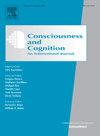The influence of self-experienced iconic finger-postures on numerical processing: Hemispheric asymmetries in semantic integration
IF 2
3区 心理学
Q2 PSYCHOLOGY, EXPERIMENTAL
引用次数: 0
Abstract
Embodied cognition theories suggest that abstract concepts, like numbers, are understood through the sensory-motor system. Iconic finger gestures have been shown to facilitate number processing, implying a shared semantic code between finger and Arabic numeral representations. This study used the Divided Visual Field paradigm to investigate where this cross-modal priming occurs in the brain. Twenty-four participants identified Arabic digits (2–3–4) by pressing a key with one hand, while their non-responding hand remained in a canonical (culturally-typical) or non-canonical finger posture. Results revealed faster reaction times in the left hemisphere when the hand was in a canonical posture but only when bodily and visual information matched within the same hemisphere. No semantic priming was observed in the right hemisphere, highlighting a hemispheric asymmetry in integrating finger-numeral and Arabic-digit representations. These findings demonstrate a clear left-hemispheric specialization in the semantic integration of finger and numeral representations, at least for small numbers.
自我经验的标志性手指姿势对数字加工的影响:语义整合中的半球不对称
具身认知理论认为抽象概念,如数字,是通过感觉-运动系统来理解的。标志性的手指手势已经被证明可以促进数字处理,这意味着手指和阿拉伯数字表示之间有一个共享的语义代码。这项研究使用分割视野范式来研究这种跨模态启动在大脑中发生的位置。24名参与者通过用一只手按下一个键来识别阿拉伯数字(2-3-4),而他们没有反应的手保持着规范的(文化典型的)或非规范的手指姿势。结果显示,当手处于标准姿势时,左半球的反应速度更快,但只有当身体和视觉信息在同一半球内匹配时才会如此。在右半球没有观察到语义启动,突出了半球在整合手指数字和阿拉伯数字表征方面的不对称性。这些发现表明,至少对于小数字来说,左半球在手指和数字表征的语义整合方面存在明显的专门化。
本文章由计算机程序翻译,如有差异,请以英文原文为准。
求助全文
约1分钟内获得全文
求助全文
来源期刊

Consciousness and Cognition
PSYCHOLOGY, EXPERIMENTAL-
CiteScore
4.30
自引率
8.30%
发文量
123
期刊介绍:
Consciousness and Cognition: An International Journal provides a forum for a natural-science approach to the issues of consciousness, voluntary control, and self. The journal features empirical research (in the form of regular articles and short reports) and theoretical articles. Integrative theoretical and critical literature reviews, and tutorial reviews are also published. The journal aims to be both scientifically rigorous and open to novel contributions.
 求助内容:
求助内容: 应助结果提醒方式:
应助结果提醒方式:


